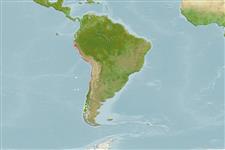Common names from other countries
Issue
Needs a taxonomic reference.
Environment: milieu / climate zone / depth range / distribution range
Écologie
marin benthopélagique; profondeur 0 - 50 m. Subtropical; 5°S - 55°S, 81°W - 70°W
Southeast Pacific: Peru to Chile. Also reported in Nicaragua (Ref. 13613).
Length at first maturity / Taille / Poids / Âge
Maturity: Lm ?, range 17 - ? cm
Max length : 60.0 cm TL mâle / non sexé; (Ref. ); poids max. publié: 183.00 g (Ref. 53696)
Over rocky and sandy bottoms. Maximum size assumed to be the same as for the family. Feeds on small crustaceans such as isopods and amphipods but also on polychaetes and algae.
Life cycle and mating behavior
Maturities | Reproduction | Spawnings | Egg(s) | Fecundities | Larves
Chirichigno, N.F., 1974. Clave para identificar los peces marinos del Peru. Inf. Inst. Mar Perú (44):1-387. (Ref. 5530)
Statut dans la liste rouge de l'IUCN (Ref. 130435)
CITES (Ref. 128078)
Not Evaluated
Menace pour l'homme
Harmless
Utilisations par l'homme
Pêcheries: commercial
Outils
Articles particuliers
Télécharger en XML
Sources Internet
Estimates based on models
Preferred temperature (Ref.
115969): 11.3 - 27.7, mean 20.5 (based on 12 cells).
Phylogenetic diversity index (Ref.
82804): PD
50 = 1.0000 [Uniqueness, from 0.5 = low to 2.0 = high].
Bayesian length-weight: a=0.01202 (0.00782 - 0.01849), b=2.97 (2.85 - 3.09), in cm Total Length, based on LWR estimates for this species & (Sub)family-body (Ref.
93245).
Niveau trophique (Ref.
69278): 2.9 ±0.39 se; based on food items.
Résilience (Ref.
120179): Milieu, temps minimum de doublement de population : 1,4 à 4,4 années (Assuming tm=2-3).
Fishing Vulnerability (Ref.
59153): Moderate vulnerability (44 of 100).
Climate Vulnerability (Ref.
125649): Moderate to high vulnerability (50 of 100).
